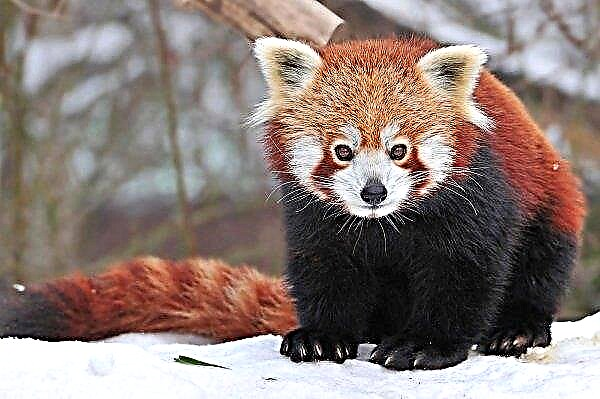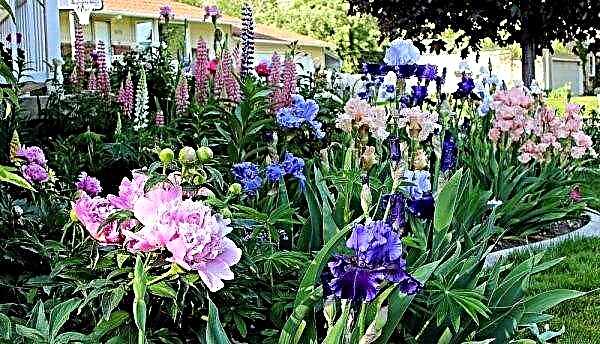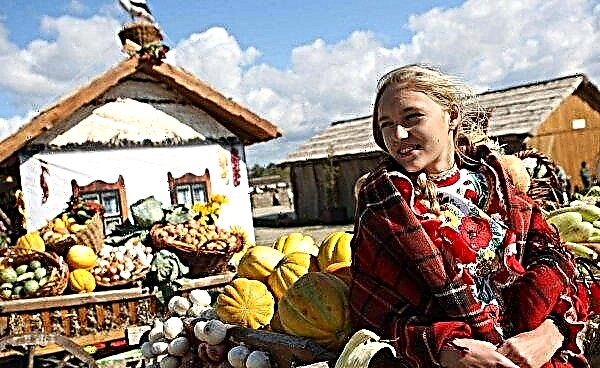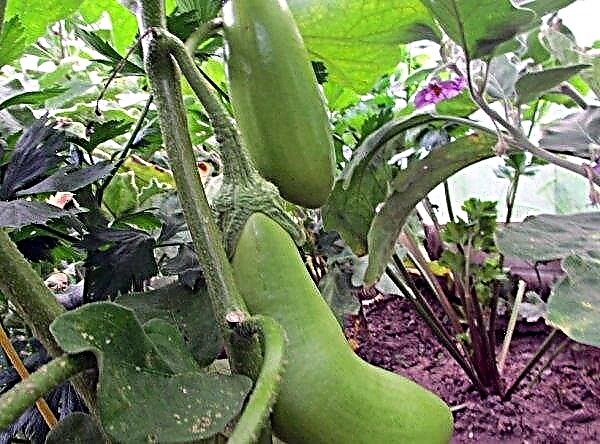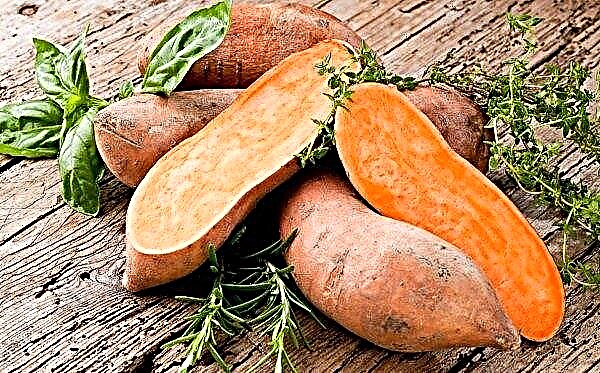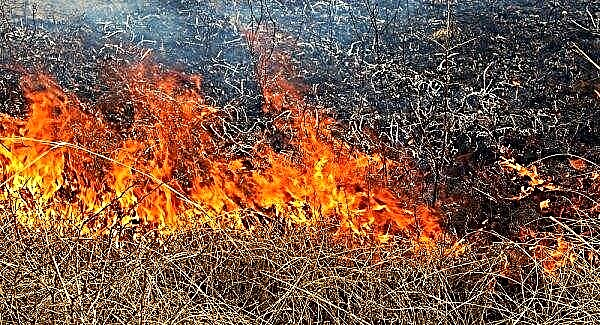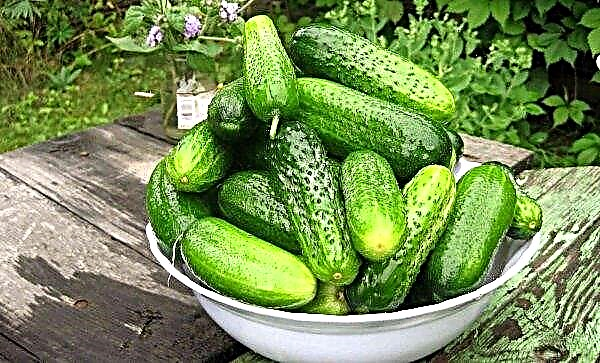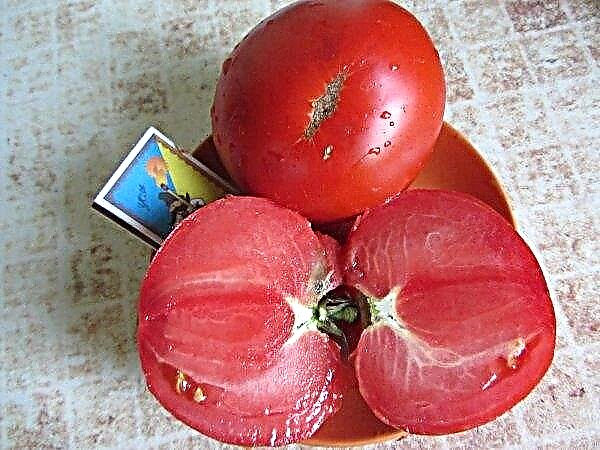Hydrangea is an excellent representative of flowering tree-like shrubs, characterized by lush and bright inflorescences, which make it a very suitable option for use in landscape design. When choosing a particular cultivar, you should pay attention to the sawtooth variety Bluebird, and what exactly it is remarkable for and what you should know about the features of caring for such shrubs will be described in the article.
Grade description
The Bluebird variety is a product of Japanese breeders, represented by shrub plants, with a strong and branched trunk. In height, adult specimens reach at least 100-120 cm, while growing in width up to one and a half meters. Oval leaf plates are saturated green and have small serrations at the edges.

The inflorescences of the bushes are flat umbrellas with a diameter of up to 10 cm. All of them consist of small single flowers, mainly pink or lilac (the stamens are painted in blue). Along the edges of the inflorescence are already larger specimens, light purple or bright blue.
If you provide the shrubber with suitable conditions for growth and development, then you can enjoy its flowering from mid-July to the end of September. The root system of the representatives of the Bluebird variety is superficial, with a depth of roots no more than 40–45 cm from the ground level.
Important! The color of hydrangea inflorescences is largely affected by the acidity of the soil at the place of shrub cultivation. If the indicators are high, the flowers will be pale blue, and at low values they always become darker.
Winter hardiness
The varieties of hydrangeas with high winter hardiness can not be attributed to Bluebird’s saw bushes, but at the same time they will be a good option for planting in the central and especially southern regions of Russia. Adult specimens without additional shelter can tolerate winter temperature drops to –20 ° Cbut it’s better to cover young seedlings in the first year of cultivation.
Landing
The main actions when planting sawtooth hydrangea Bluebird in many ways resemble the work performed during the planting of other varieties of ornamental shrubs on the site, with the exception of certain nuances in terms of timing and the algorithm of planting events.
Landing time
Despite the rather mediocre frost resistance of hydrangea Bluebird, it can be planted both in spring and autumn, but as for the latter option, it will be more suitable for the southern territories of the Russian Federation.
In the central regions (including the Moscow region), as well as in some northern regions (located closer to the central part of the country), it is advisable to plant seedlings in late April or early May, so that they can adapt to the next winter cold in a new place and did not freeze.
Autumn planting in the southern regions of Russia is usually carried out at the beginning - mid-September, provided that at least two months remain to minus temperatures.

Landing rules
To get a beautiful flowering bush of hydrangea Bluebird, it is important to know about some rules for the preparation and direct planting of young plants on the site.
Did you know? The appearance of blue shades in the color of hydrangea flowers is explained by the consumption of aluminum from acidic soils. This is one of the few plants capable of accumulating this element.
The main recommendations in this case will be the following:
- When choosing a place for hydrangea planting, give preference to sheltered from the wind, slightly shaded areas, growing on which the bush can be illuminated by scattered sunlight.
- The dimensions of the average landing hole should correspond to 50 cm in diameter and not less than 40 cm in depth, although when using a seedling with a closed root system, you should focus on the dimensions of the earthen coma already in the container (in this case, the depth of the landing pit should be 10-15 cm deeper than the bottom of the seedling).
- To create a suitable soil cushion, it is better to mix together 2 parts of humus and leaf soil, one part of peat and sand, and then add another 20 g of urea or complex mineral fertilizers to them.
- Before planting, it is useful to soak the roots of the plant for several hours in a root stimulant solution (for example, in Kornevin), and moisten the soil in the hole well.
- When filling the hydrangea rhizome with soil, make sure that its root neck remains 2 cm above ground level. After the next watering, it will drop to the ground level.
- To keep the moisture in the soil for a long time, the trunk area of the shrub is mulched with a 5-centimeter layer of shredded pine bark or sawdust.
- If hydrangeas will be used in the composition, then at least one and a half meters should be left between adjacent plants. The process of planting Bushes of the Bluebird variety cannot be called a very difficult task, and in preparing everything in advance it will not take more than 10-15 minutes.

Care Features
For the fast growth and abundant flowering of the Bluebird bushes, when growing them, it is worthwhile to pay sufficient attention to watering, fertilizing, pruning and shading the crop, not to mention the care of the soil in the near-stem zone and the construction of a winter shelter. Each of these actions will have its own characteristics, which must be taken into account before planting a seedling on the site.
Watering
Hydrangea (including the described variety) refers to hygrophilous crops. In the first year after planting seedlings, they are watered at least 3-4 times a week, and on especially hot summer days (with air temperature above + 30 ° C) - up to two times a day (morning and evening). The topsoil under the bush should always be slightly moistotherwise the plant will not be able to bloom profusely, and its growth will slow down.

Direct sunlight protection
Despite the photophilia of hydrangea, the constant exposure to direct sunlight on its leaves and flowers can harm them, resulting in the drying of leaf plates and the appearance of unsightly brown burn spots on them. In addition, too intense sunlight contributes to the shredding of flowers and the rapid evaporation of moisture from the soil.
To prevent such undesirable consequences in the afternoon, it is worth shading bushesusing the previously installed removable canopy. This can be a stretch of material stretched over the supports or a more professional retractable visor made of durable material (for example, plastic).
Did you know? In honor of hydrangea, they allocated one day a year - January 5. However, at this time, garden plants do not bloom, so in order to celebrate it with flowers, you will have to acquire potted crops.
Fertilizer and fertilizer
For the first time, the Bluebird hydrangea bushes are fed when they are planted on the site, pouring ready-made mineral fertilizers and ammonium nitrate into the planting pit. The second and third fertilizers are usually carried out only the next year: before laying flower buds and at the initial stages of their flowering.

In the last two cases, complex mineral mixtures with the presence of potassium (available at stores for flowering plants) or a mixture of compost diluted in water (1:10) are perfect for the role of a nutritional composition. The optimal interval between feeding is 2-3 weeks.
Loosening
Loosening the soil under hydrangeas involves the removal of a dense, dried crust of earth that prevents moisture and air from entering the roots of the crop. With insufficient moisture and air exchange, plant growth is inhibited, they lose their decorative qualities.
It is recommended to loosen the soil soon after the next moistening of the soil.as soon as water is well absorbed into the thickness of the substrate. At the same time, one should not forget about the superficial type of rhizome of hydrangea, which means that it is possible to deepen a rake when loosening no more than by 10 cm. On average, at least 2-3 such procedures are performed in one summer season.
Pruning
For hydrangea Bluebird, annual pruning will be important, with the removal of damaged, diseased branches and faded buds. If possible, it is worth planning to perform these actions at the end of September or the beginning of October, when the plant enters a dormant state.
The main tool in this case is a sharp garden pruner, which, in addition to the listed parts of the bush, also cut the upper pieces of branches (by 2-3 knots), trying to form a kind of cap from the crown.
 During sanitary pruning, non-fruiting specimens are also included in the list of shoots mandatory for removal, therefore, if flowers have not appeared on some branches this year, they are cut off.
During sanitary pruning, non-fruiting specimens are also included in the list of shoots mandatory for removal, therefore, if flowers have not appeared on some branches this year, they are cut off.
An acceptable option would be summer pruning of branches (helps to increase the branching of the bush), and after 2-3 years of growing shrubs on the site, a more radical haircut is performed, in which, together with broken or diseased parts, incorrectly growing and weak shoots are removed.
Winter preparations
Adult bushes tolerate winter temperature drops much easier than young hydrangeas, therefore they are seriously insulated only in the northern regions, which are characterized by winter minus temperatures below –20 ° C.
Important! As soon as spring, stable, warm weather sets in with positive air temperature, the shelter should be taken apart immediately, without waiting for the plant to begin to shine under it. The formation inside the condensate threatens to rot its individual parts.
In total, the preparation of Bluebird bushes for wintering is reduced to the following actions:
- hilling of young plants and their shelter with polyethylene (if the thermometer has reached –5 ° C);
- tying sapling branches with a tourniquet, hilling them and warming with spruce spruce branches, and, if necessary, additional shelter with several layers of polyethylene (in case of lowering the indicators to –15 ° C);
- warming of shoots fixed near the ground with coniferous branches, sawdust and any warm materials (from –20 ° C);
- wrapping the shoots with a metal mesh, bricking them and additional warming with old things (at temperatures below –30 ° C).

In regions with severe winters, two-layer warming of bushes is practiced, when the branches collected in a bundle are first placed in a tube-like structure and covered with sawdust or fallen leaves, they are covered with bricks on the outside and additionally covered with lapnik. In most cases, such a shelter is enough even for very severe northern winters.
Breeding methods
If one or several instances of Bluebird hydrangea is already growing on the site, then the most beneficial ways for the gardener to propagate them are cuttings, using layering or dividing the bush. Seed propagation is used much less frequently, which is related to the difficulties of the process itself., and with the possibility of obtaining new copies, little similar to the mother plant.
Cuttings are the most convenient option for increasing the number of hydrangea bushes.
The process in stages:
- Planting material (cuttings) is harvested before buds open, highlighting branches with 1-2 knots and several leaves.
- Without departing from the upper node, the shoot is cut off at a right angle, and an oblique cut is performed under the lower node.
- Only a few small specimens can be left from the leaves, and the rest will have to be removed.

- In this form, the stalk is planted in a soil-sand mixture (you can use the recipe to fill the hole when planting a seedling), only you need to deepen it no more than 1-2 cm.
- With daily ventilation and regular moistening of the soil from the spray gun, after a year, it will be possible to transplant the rooted seedling into the greenhouse.

When the bushes are propagated by layering, a healthy lateral shoot (one or several) is selected, the bark is partially removed from its central part, and then they are dug in an organized 5-centimeter trench, leaving only the end of the shoot on the surface. Watering and feeding the layering, after about a year it is separated from the mother bush and planted in the selected place as an independent seedling.
Hydrangea bush division is used for its propagation much less frequently and only if the selected mother plant is large enough and has a well-developed rhizome. After dissection, a strong central root and smaller specimens extending from it should remain on each part. Further planting of parts on the bed is carried out in accordance with the general rules.

Seed propagation is an actual procedure when growing Bluebird hydrangea in nurseries or scientific horticultural centers, where plants are often used for breeding purposes. At home, a large number of seeds just do not germinate, and those that give sprouts, usually can not boast of high decorativeness.
Diseases and Pests
The list of the most common problems in the cultivation of the described hydrangea includes the following:
- Chlorosis - a disease manifested in the dimming and lightening of the surface of the leaf plates, although the veins remain the same color. To cure the bushes, they are treated twice a day with a solution of potassium nitrate and vitriol, previously dissolving 4 g of each substance in 1 liter of water.

- Powdery mildew - an ailment recognizable by the appearance on the hydrangea leaves of yellow and brown spots, with a powdery coating on the surface of the lesions. The easiest way to combat this is to spray the crown twice daily with a mixture of 10 g of laundry soap and 1.5 g of copper sulfate dissolved in a liter of water.

- Spider mite - A popular pest of horticultural crops, affecting mainly the lower part of the leaf plate. As a result of its activity, the leaves grow dull, turn yellow and fall, and if you look closely at them, you can find a brown cobweb. In the fight against insects use the drug "Thiophos" and other similar insecticidal compounds.

As a preventative measure, in early spring, the hydrangea crown is sprayed with Karbofos, copper sulfate and Bordeaux mixture, repeating the procedure with an interval of 2 weeks.
Important! To protect flowering shrubs from rot will help control soil moisture in the near-stem zone. Water should not stagnate at the root of the plant — otherwise, it will be necessary to organize the removal of moisture from the bush artificially or simply transplant the plant to another growth site.
In general, hydrangea of the Bluebird variety is a good solution for decorating a garden or a house adjoining territory. With comparative unpretentiousness to the growing conditions, the bushes of the culture will always delight you with lush and plentiful flowers, you only need to pay them a little attention.







